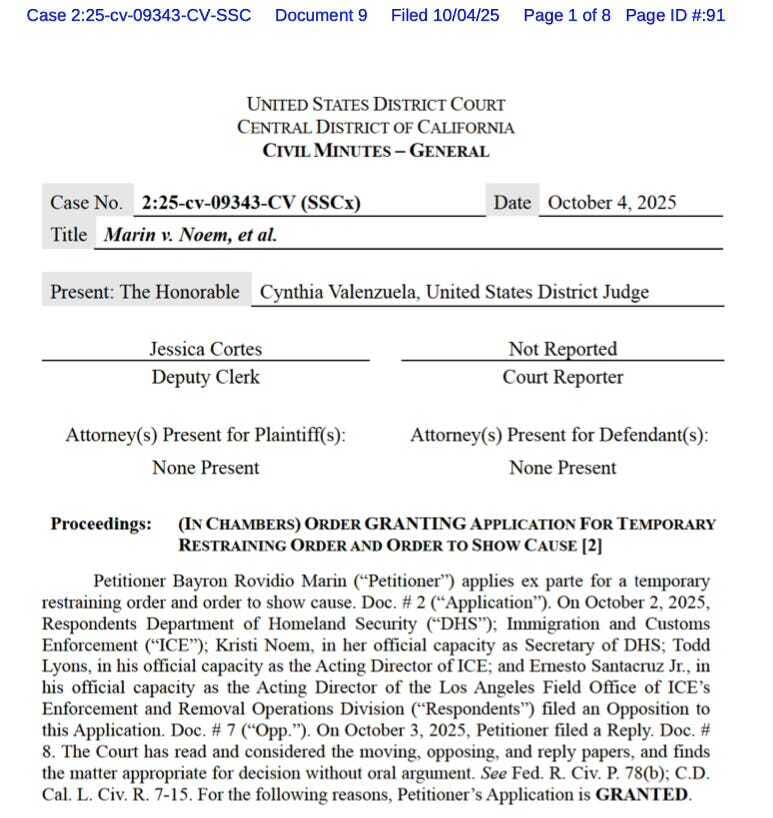- Pascal's Chatbot Q&As
- Posts
- The petitioner—a person with a broken leg and no formal charges—was effectively disappeared into a bureaucratic black hole, stripped of liberty, privacy, and due process.
The petitioner—a person with a broken leg and no formal charges—was effectively disappeared into a bureaucratic black hole, stripped of liberty, privacy, and due process.
This case paints a disturbing picture of systemic overreach by ICE, revealing a disregard for constitutional protections, transparency, and human dignity. Such conduct corrodes the rule of law.
The Misconduct of ICE as Documented in Court Records – A Systemic Violation of Rights
by ChatGPT-4o
The civil court document filed in Case 2:25-cv-09343-CV-SSC offers a detailed, sobering account of the U.S. Immigration and Customs Enforcement (ICE) and affiliated agencies’ handling of one detainee, exposing a troubling pattern of rights violations and misconduct. The case concerns a petitioner who was arrested, injured, and held in extreme conditions without legal basis or due process. The documented actions of ICE not only raise serious constitutional concerns but also call into question the agency’s commitment to lawful and humane enforcement practices.
🚨 Key Violations and Abuses by ICE and Related Entities
1. Warrantless Arrest and Severe Injury Without Justification
The petitioner was arrested at a car wash in Carson, California, by uniformed CBP officers and unidentified plainclothes federal agents without a warrant or any stated legal justification. During the arrest, he suffered severe leg injuries. The government provided no factual basis for the arrest or evidence that the petitioner was in violation of immigration law or posed a flight risk—requirements for a lawful warrantless arrest under 8 U.S.C. § 1357(a)(2).
“Respondents identify no facts supporting such a belief.”
– Court, Page 4
2. Black Site-Like Secrecy and Use of Pseudonyms
Once in the hospital, the petitioner was admitted under a “blackout” procedure and registered under the pseudonym “Har Maine UNK Thirteen”, a tactic more reminiscent of clandestine intelligence operations than civil law enforcement. This obscured his identity from the public and even from potential legal advocates.
3. Continuous Surveillance and Physical Restraint in Medical Care
While hospitalized with a broken leg, the petitioner was kept handcuffed to his bed, even though he was physically incapable of fleeing. He was constantly surveilled by 2–4 guards, including during sleep, meals, medical care, and restroom use. These measures served no clear security purpose and constituted a gross invasion of dignity and bodily autonomy.
4. Obstruction of Legal Representation and Communication
ICE:
Initially denied the petitioner access to legal counsel,
Later permitted visits only in the presence of deportation officers (eliminating confidentiality),
Prohibited phone calls, even to attorneys, and
Barred family visits.
This created a legal black hole where the petitioner was detained with no meaningful access to due process.
“The record further shows that Petitioner has communicated with counsel and medical staff throughout his detention.”
– Court, Page 5
5. Coercive Questioning While in Pain and Under Medication
Despite ICE’s claim that they could not process the detainee due to his medical state, they interrogated him about his place of birth and immigration status while he was in pain or medicated, undermining the validity of any statements made.
6. Failure to Process or Charge the Detainee for Over 37 Days
The petitioner remained in detention without:
Being charged with a crime,
Receiving a Notice to Appear,
Having an “A number” assigned,
Being scheduled for a bond hearing, or
Receiving any formal justification for his continued custody.
Such prolonged uncharged detention violates the Fifth Amendment and applicable federal regulations requiring timely processing.
7. Lack of Transparency and Stonewalling Legal Requests
ICE refused to provide:
A judicial warrant for the arrest,
Charging documents, or
Any other lawful authority for detention.
This evasion flies in the face of legal standards requiring transparency, especially in cases involving detention.
8. Unlawful Prolonged Detention Beyond Regulatory Limits
ICE failed to comply with 8 C.F.R. § 287.3(d), which mandates that within 48 hours of a warrantless arrest, the government must make a custody determination and issue charging documents. ICE made no such determination for over five weeks, and no valid “extraordinary circumstance” was demonstrated to justify the delay.
“Petitioner has been detained for more than 37 days... Respondents do not explain how this emergency has prevented them from making a Section 287.3 determination.”
– Court, Page 5
⚖️ Judicial Conclusion
The court concluded that:
The arrest and continued detention lack statutory authority,
The petitioner’s constitutional rights were likely violated, and
The balance of equities and public interest clearly favored the petitioner.
ICE was ordered to:
Remove all restraints and guards from the petitioner’s hospital room,
Cease obstructing legal counsel and family access, and
Refrain from further impairing the petitioner’s liberty without due process.
📌 Conclusion and Recommendations
This case paints a disturbing picture of systemic overreach by ICE, revealing a disregard for constitutional protections, transparency, and human dignity. The petitioner—a person with a broken leg and no formal charges—was effectively disappeared into a bureaucratic black hole, stripped of liberty, privacy, and due process.
🔧 Recommendations:
For Lawmakers and Regulators:
Enforce mandatory due process safeguards for all immigration detainees.
Prohibit ICE from using pseudonyms and blackout procedures without judicial oversight.
Require public reporting on uncharged detention durations and warrantless arrests.
For the Judiciary:
Treat prolonged ICE detention without formal charges as a presumption of unconstitutionality.
Mandate access to counsel and prohibit surveillance during attorney-client meetings.
For Civil Rights Organizations:
Establish hotlines and legal assistance programs targeting detainees in hospitals and other non-standard detention settings.
Investigate ICE partnerships with private security firms like Spectrum Detention Services for potential abuses.
For the Public and Press:
Demand transparency and reporting on medical detentions.
Challenge ICE’s use of secrecy and blacksite-like protocols through FOIA requests and oversight pressure.
This case is not an isolated failure—it is a stark warning. If allowed to persist, such conduct corrodes the rule of law, undermines the legitimacy of immigration enforcement, and risks transforming hospitals into prisons by proxy.
